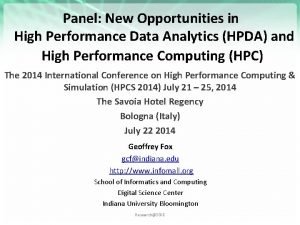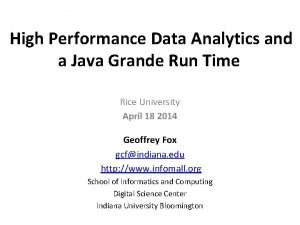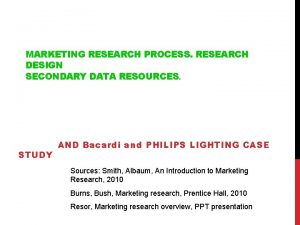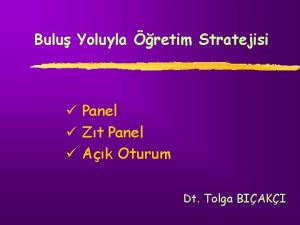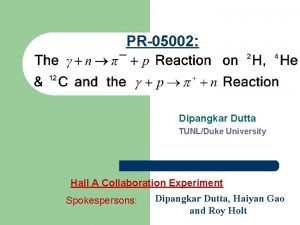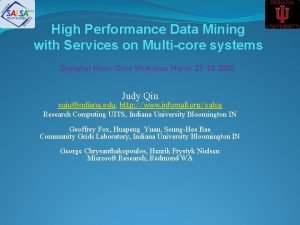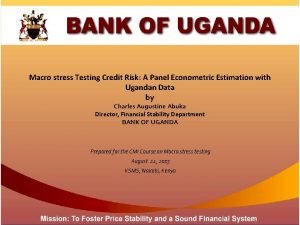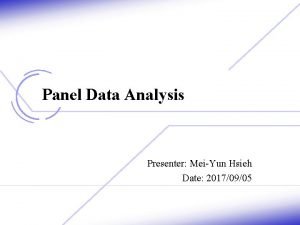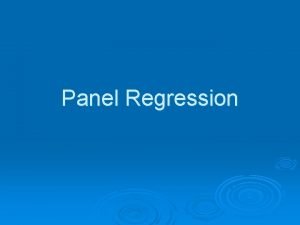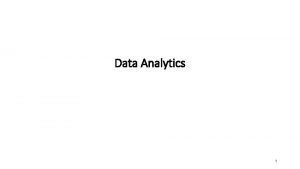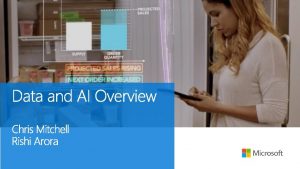Panel New Opportunities in High Performance Data Analytics









- Slides: 9

Panel: New Opportunities in High Performance Data Analytics (HPDA) and High Performance Computing (HPC) The 2014 International Conference on High Performance Computing & Simulation (HPCS 2014) July 21 – 25, 2014 The Savoia Hotel Regency Bologna (Italy) July 22 2014 Geoffrey Fox gcf@indiana. edu http: //www. infomall. org School of Informatics and Computing Digital Science Center Indiana University Bloomington Research@SOIC

SPIDAL (Scalable Parallel Interoperable Data Analytics Library) Research@SOIC 2

Introduction to SPIDAL • Learn from success of Pet. Sc, Scalapack etc. as HPC Libraries • Here discuss Global Machine Learning GML as part of SPIDAL (Scalable Parallel Interoperable Data Analytics Library) – GML = Machine Learning parallelized over nodes – LML = Pleasingly Parallel; Machine Learning on each node • Surprisingly little packaged scalable GML – Apache: Mahout low performance and MLlib just starting – R largely sequential (best for local machine learning LML) • Our experience based on four big data algorithms – Dimension Reduction (Multi Dimensional Scaling) – Levenberg-Marquardt Optimization – Clustering: similar to Gaussian Mixture Models, PLSI (probabilistic latent semantic indexing), LDA (Latent Dirichlet Allocation) – Deep Learning Research@SOIC 3

Some Core Machine Learning Building Blocks Algorithm Applications Features Status //ism DA Vector Clustering DA Non metric Clustering Kmeans; Basic, Fuzzy and Elkan Levenberg-Marquardt Optimization Accurate Clusters Vectors P-DM GML Accurate Clusters, Biology, Web Non metric, O(N 2) Fast Clustering Vectors Non-linear Gauss-Newton, use Least Squares in MDS Squares, DA- MDS with general weights Least 2 O(N ) DA-GTM and Others Vectors Find nearest neighbors in document corpus Bag of “words” Find pairs of documents with (image features) TFIDF distance below a threshold P-DM GML P-DM GML P-DM PP Todo GML Support Vector Machine SVM Learn and Classify Vectors Seq GML Random Forest Gibbs sampling (MCMC) Latent Dirichlet Allocation LDA with Gibbs sampling or Var. Bayes Singular Value Decomposition SVD Learn and Classify Vectors P-DM PP Solve global inference problems Graph Todo GML Topic models (Latent factors) Bag of “words” P-DM GML Dimension Reduction and PCA Vectors Seq GML Hidden Markov Models (HMM) Research@SOIC Global inference on sequence Vectors models Seq 4 PP & GML SMACOF Dimension Reduction Vector Dimension Reduction TFIDF Search All-pairs similarity search

Some General Issues Parallelism Research@SOIC 5

Some Parallelism Issues • All use parallelism over data points – Entities to cluster or map to Euclidean space • Except deep learning which has parallelism over pixel plane in neurons not over items in training set – as need to look at small numbers of data items at a time in Stochastic Gradient Descent • Maximum Likelihood or 2 both lead to structure like • Minimize sum items=1 N (Positive nonlinear function of unknown parameters for item i) • All solved iteratively with (clever) first or second order approximation to shift in objective function – Sometimes steepest descent direction; sometimes Newton – Have classic Expectation Maximization structure Research@SOIC 6

Parameter “Server” • Note learning networks have huge number of parameters (11 billion in Stanford work) so that inconceivable to look at second derivative • Clustering and MDS have lots of parameters but can be practical to look at second derivative and use Newton’s method to minimize • Parameters are determined in distributed fashion but are typically needed globally – MPI use broadcast and “All. . Collectives” – AI community: use parameter server and access as needed Research@SOIC 7

Some Important Cases • Need to cover non vector semimetric and vector spaces for clustering and dimension reduction (N points in space) • Vector spaces have Euclidean distance and scalar products – Algorithms can be O(N) and these are best for clustering but for MDS O(N) methods may not be best as obvious objective function O(N 2) • MDS Minimizes Stress (X) = i<j=1 N weight(i, j) ( (i, j) - d(Xi , Xj))2 • Semimetric spaces just have pairwise distances defined between points in space (i, j) • Note matrix solvers all use conjugate gradient – converges in 5 -100 iterations – a big gain for matrix with a million rows. This removes factor of N in time complexity – Full matrices not sparse as in HPCG • In clustering, ratio of #clusters to #points important; new ideas if ratio >~ 0. 1 • There is quite a lot of work on clever methods of reducing O(N 2) to O(N) and logs – This is extensively used in search but not in “arithmetic” as in MDS or semimetric clustering – Arithmetic similar to fast multipole methods in O(N 2) particle dynamics Research@SOIC 8

Some Futures • Always run MDS. Gives insight into data – Leads to a data browser as GIS gives for spatial data • Claim is algorithm change gave as much performance increase as hardware change in simulations. Will this happen in analytics? – Today is like parallel computing 30 years ago with regular meshs. – We will learn how to adapt methods automatically to give “multigrid” and “fast multipole” like algorithms • Need to start developing the libraries that support Big Data – Understand architectures issues – Have coupled batch and streaming versions – Develop much better algorithms • Please join SPIDAL (Scalable Parallel Interoperable Data 9 Analytics Library) community Research@SOIC
